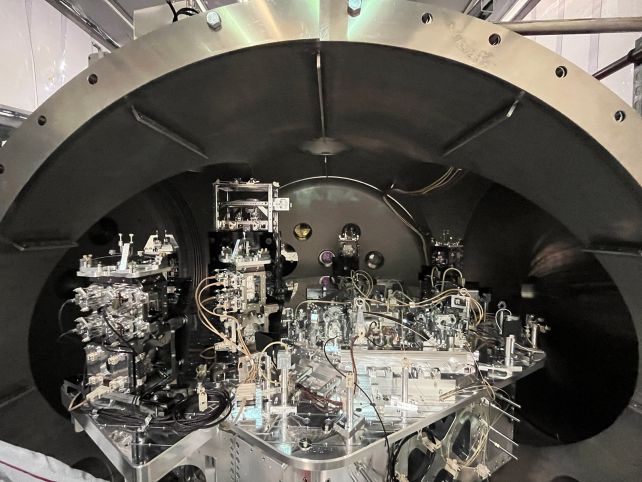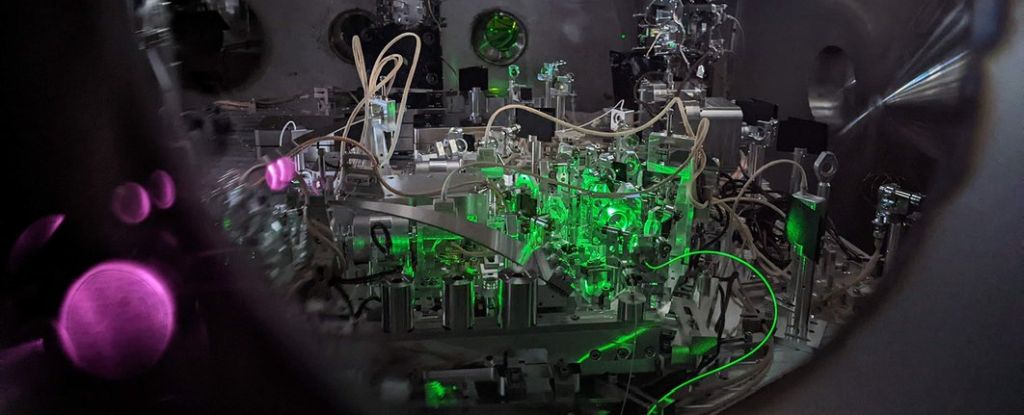Products You May Like
A technique for squeezing light in the arms of LIGO’s interferometer has allowed its measurements to cross the quantum barrier.
For LIGO (the Laser Interferometer Gravitational-Wave Observatory), it’s a bold new realm of sensitivity, giving the gravitational wave detector the ability to find 60 percent more dead star mergers than the rate of its previous run, which was around one or two detections every week or so.
The technique is called frequency-dependent squeezing, circumventing previous limitations that prevented LIGO from making detections on quantum scales.
“Now that we have surpassed this quantum limit, we can do a lot more astronomy,” says physicist Lee McCuller of Caltech. “LIGO uses lasers and large mirrors to make its observations, but we are working at a level of sensitivity that means the device is affected by the quantum realm.”
LIGO’s sensitivity was already absolutely jaw-dropping. The interferometer works by detecting ripples in space-time that are generated by colliding black holes and neutron stars, millions of billions to light-years away.
These cause gravitational waves, like ripples in a pond. We can’t feel them; but they can be detected in miniscule deviations in the path of light down a long, long tunnel.

These deviations are incredibly small, down to trillions of times smaller than a human hair. But once you get into subatomic scales – the quantum realm – LIGO’s abilities are hobbled. That’s because, on those unimaginably small scales, particles randomly pop in and out of space, creating a constant background hiss of quantum noise that’s louder than any signal.
Frequency-dependent squeezing is a way of amplifying the signals to be ‘louder’ than the quantum noise. It is, physicists say, a bit like squeezing a balloon. When you squeeze a balloon at one end, the other end gets bigger. Likewise, if you pinch a property of light, such as amplitude (or power), other properties, such as frequency, can be measured more accurately.
But, although you might gain precision in one area, you lose it in the other. LIGO has had technology for frequency-dependent squeezing since 2019, but it wasn’t particularly flexible. The new upgrade means that the squeezing is more flexible; the light can be squeezed in multiple ways to amplify the frequency of the gravitational waves the scientists are looking for.
“Before, we had to choose where we wanted LIGO to be more precise,” says physicist Rana Adhikari of Caltech. “Now we can eat our cake and have it too. We’ve known for a while how to write down the equations to make this work, but it was not clear that we could actually make it work until now. It’s like science fiction.”
The technology works through the use of crystals that turn single stray photons in LIGO’s 4-kilometer-long vacuum tubes into two entangled photons with lower energy.
These photons interact with the laser beams that shine down the tunnels to squeeze the laser light in the desired way. When gravitational waves rumble through, these laser beams are jiggled in such a way that the motion can be picked up at the other end.
The new frequency-dependent squeezing technology works by alternating the way it squeezes light, so that both higher and lower frequencies are amplified. It’s been in operation since LIGO’s current observing run started in May, and will likely be installed in the Virgo detector in Italy before the observing run is ended.
This means we’re likely to see a significant uptick in the number of black hole and neutron star collisions we observe out there in the wider Universe.
“We are finally taking advantage of our gravitational Universe,” says physicist Lisa Barsotti of MIT. “In the future, we can improve our sensitivity even more. I would like to see how far we can push it.”
The research will be published in Physical Review X.
